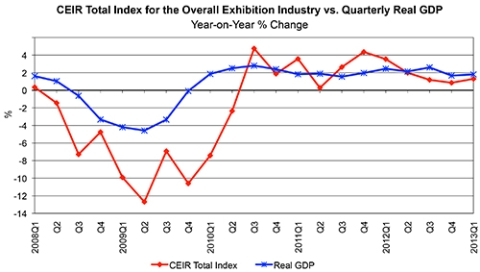CEIR Index Indicates 1.3 Percent Q1 Growth Rate in Trade Show Industry

The pace of growth may be slowing, but the trade show industry still just keeps moving in a positive direction, with the Center for Exhibition Industry Research’s Index showing a 1.3-percent increase to kick off the first quarter of this year, compared with the same time period last year.
Even though it’s the eleventh straight quarter with an uptick, the year started out lagging behind the overall GDP, which saw 1.8 percent growth, compared with Q1 2012.
The fourth quarter of 2012 ended with a more modest growth rate of 0.9 percent, according to CEIR.
"Overall, the first-quarter results are positive and confirm that the exhibition industry has survived and emerged from the recession," said CEIR's economist Allen Shaw, Ph.D., chief economist for Global Economic Consulting Associates.
He added, "With 11 consecutive quarters of growth, as well as our predictions closely matching outcomes, we are confident in the continued growth and progress of the industry."
Good news for shows was that net square footage and exhibitors both saw positive gains, 2.3 and 2.2 percent, respectively, in the first quarter of this year, along with revenue, with a 1.0-percent increase.
After several quarters of attendance growth, however, there was a small decline of 0.2 percent in the first quarter of 2013, which CEIR attributed to less participation from government personnel.
With not only increased scrutiny on events in the government sector, but also sequestration, both are challenges faced in not only specific sector, but also shows that typically draw government attendees.
"With the decline in attendance, we are closely monitoring business-to-business exhibitions especially for trade shows that depend on government employees' participation to determine how much of the attendance decline is directly attributable to Sequestration," said CEIR President and CEO Douglas L. Ducate, CEM, CMP.
He added, "Based on media reports from lawmakers in Washington, it appears unlikely that both parties will reach an agreement on a ‘grand bargain’ in the near future; therefore, this period of uncertainty is likely to continue through 2013."
The CEIR Index measures year-over-year changes in four key metrics to determine overall performance: Net Square Feet of Exhibit Space Sold; Professional Attendance; Number of Exhibiting Companies; and Gross Revenue.
The CEIR Index also provides exhibition industry performance across 14 key industry sectors.


Add new comment